Leading Change and Managing: IBM's Strategies, Policies and Practices
VerifiedAdded on 2023/06/18
|15
|4482
|446
Report
AI Summary
This report provides an in-depth analysis of IBM's change management strategies and management practices within the context of a VUCA (Volatile, Uncertain, Complex, Ambiguous) environment. It explores how corporate strategies and management practices have been affected by the current business climate, influencing business approaches and highlighting challenges faced by IBM, including issues with people management and slow reaction to market changes. The report also examines recent changes within the company, supported by relevant change management theory, specifically Lewin's change management theory, focusing on training needs, customer relations, and technological advancements. Furthermore, it discusses the evolution of business policies and practices aimed at improving employee support and minimizing resistance to change, such as performance-based rewards and flatter organizational structures. The report concludes with recommendations for key areas within IBM's business, emphasizing the importance of adapting to change, improving employee relations, and leveraging technology for future growth. This document is available on Desklib, where students can find a variety of solved assignments and past papers.
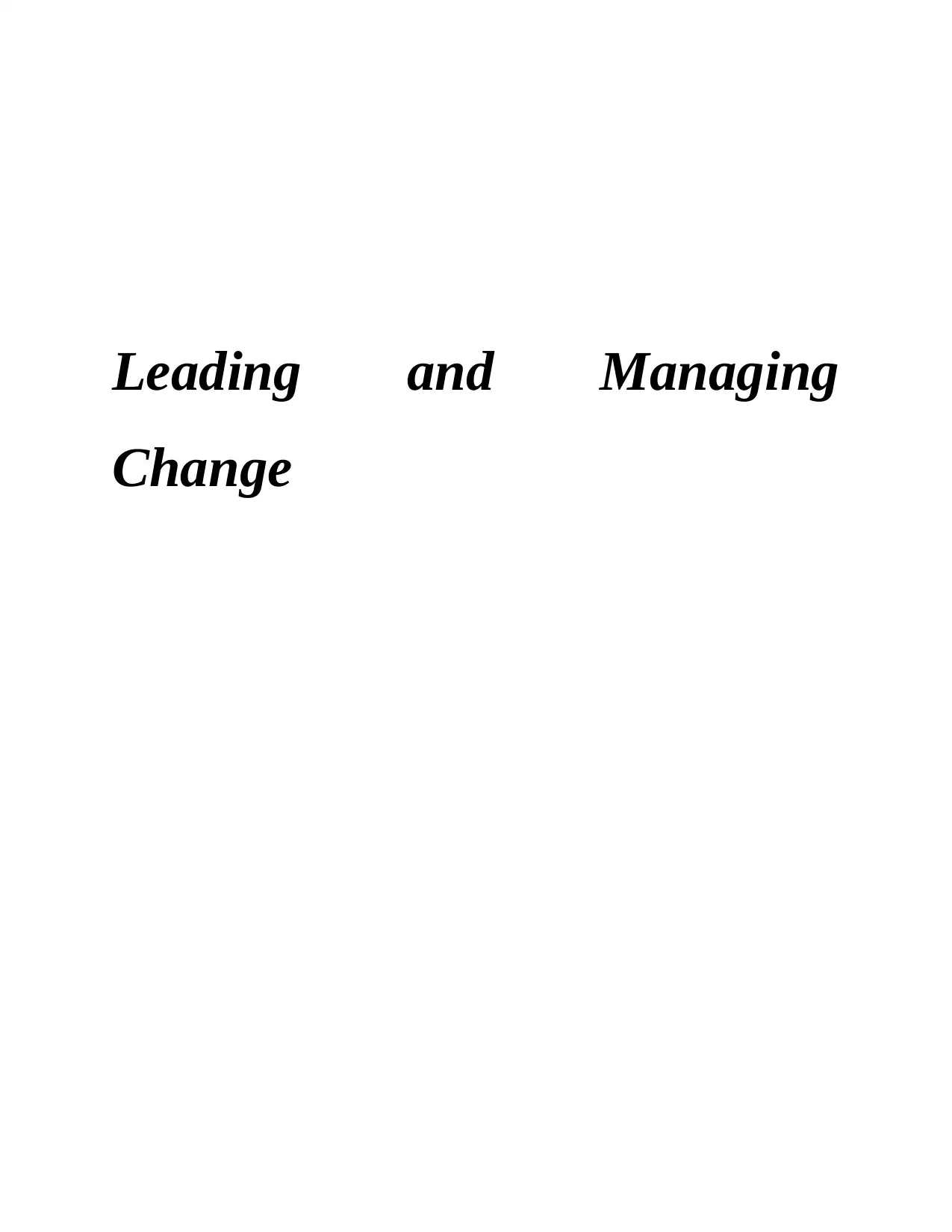
Leading and Managing
Change
Change
Paraphrase This Document
Need a fresh take? Get an instant paraphrase of this document with our AI Paraphraser
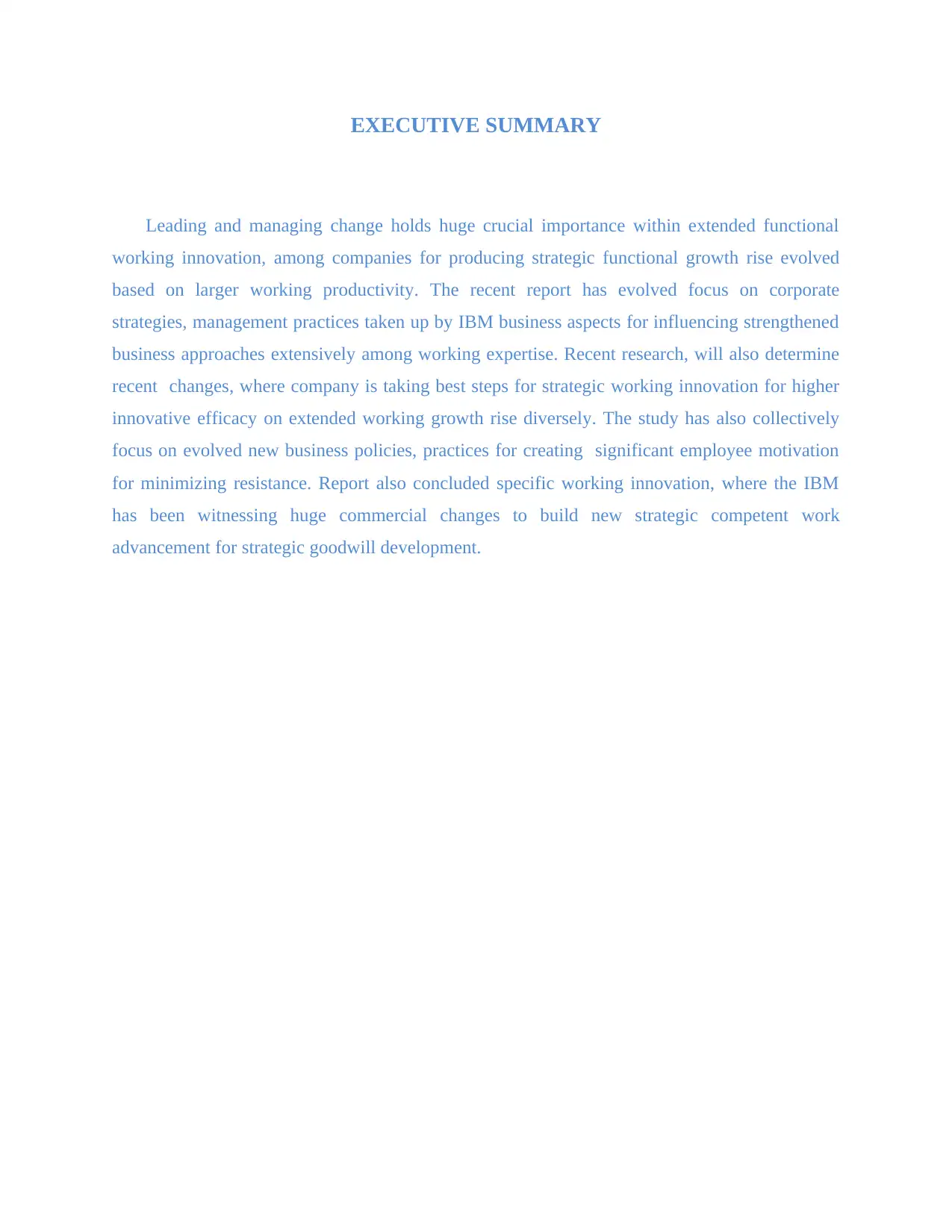
EXECUTIVE SUMMARY
Leading and managing change holds huge crucial importance within extended functional
working innovation, among companies for producing strategic functional growth rise evolved
based on larger working productivity. The recent report has evolved focus on corporate
strategies, management practices taken up by IBM business aspects for influencing strengthened
business approaches extensively among working expertise. Recent research, will also determine
recent changes, where company is taking best steps for strategic working innovation for higher
innovative efficacy on extended working growth rise diversely. The study has also collectively
focus on evolved new business policies, practices for creating significant employee motivation
for minimizing resistance. Report also concluded specific working innovation, where the IBM
has been witnessing huge commercial changes to build new strategic competent work
advancement for strategic goodwill development.
Leading and managing change holds huge crucial importance within extended functional
working innovation, among companies for producing strategic functional growth rise evolved
based on larger working productivity. The recent report has evolved focus on corporate
strategies, management practices taken up by IBM business aspects for influencing strengthened
business approaches extensively among working expertise. Recent research, will also determine
recent changes, where company is taking best steps for strategic working innovation for higher
innovative efficacy on extended working growth rise diversely. The study has also collectively
focus on evolved new business policies, practices for creating significant employee motivation
for minimizing resistance. Report also concluded specific working innovation, where the IBM
has been witnessing huge commercial changes to build new strategic competent work
advancement for strategic goodwill development.
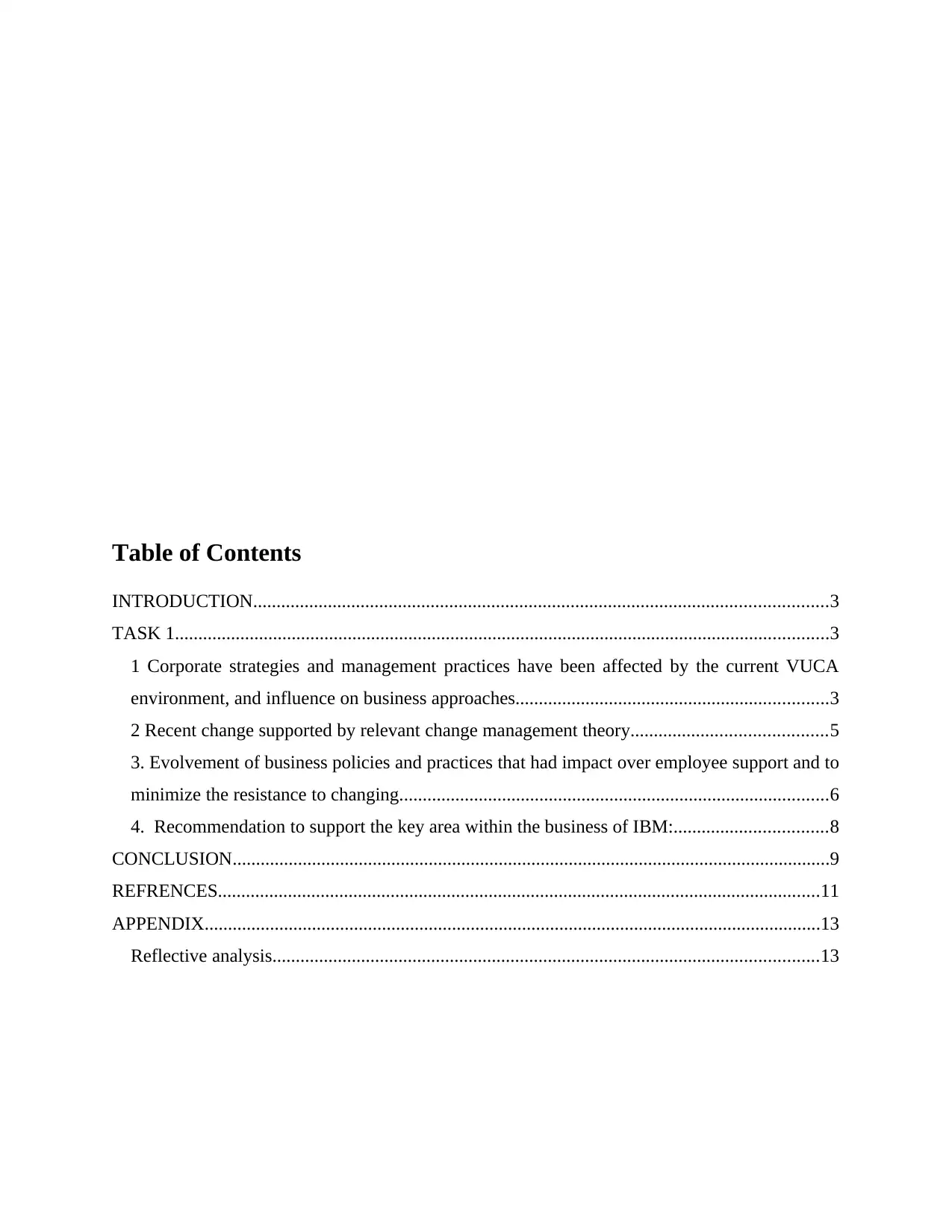
Table of Contents
INTRODUCTION...........................................................................................................................3
TASK 1............................................................................................................................................3
1 Corporate strategies and management practices have been affected by the current VUCA
environment, and influence on business approaches...................................................................3
2 Recent change supported by relevant change management theory..........................................5
3. Evolvement of business policies and practices that had impact over employee support and to
minimize the resistance to changing............................................................................................6
4. Recommendation to support the key area within the business of IBM:.................................8
CONCLUSION................................................................................................................................9
REFRENCES.................................................................................................................................11
APPENDIX....................................................................................................................................13
Reflective analysis.....................................................................................................................13
INTRODUCTION...........................................................................................................................3
TASK 1............................................................................................................................................3
1 Corporate strategies and management practices have been affected by the current VUCA
environment, and influence on business approaches...................................................................3
2 Recent change supported by relevant change management theory..........................................5
3. Evolvement of business policies and practices that had impact over employee support and to
minimize the resistance to changing............................................................................................6
4. Recommendation to support the key area within the business of IBM:.................................8
CONCLUSION................................................................................................................................9
REFRENCES.................................................................................................................................11
APPENDIX....................................................................................................................................13
Reflective analysis.....................................................................................................................13
⊘ This is a preview!⊘
Do you want full access?
Subscribe today to unlock all pages.

Trusted by 1+ million students worldwide
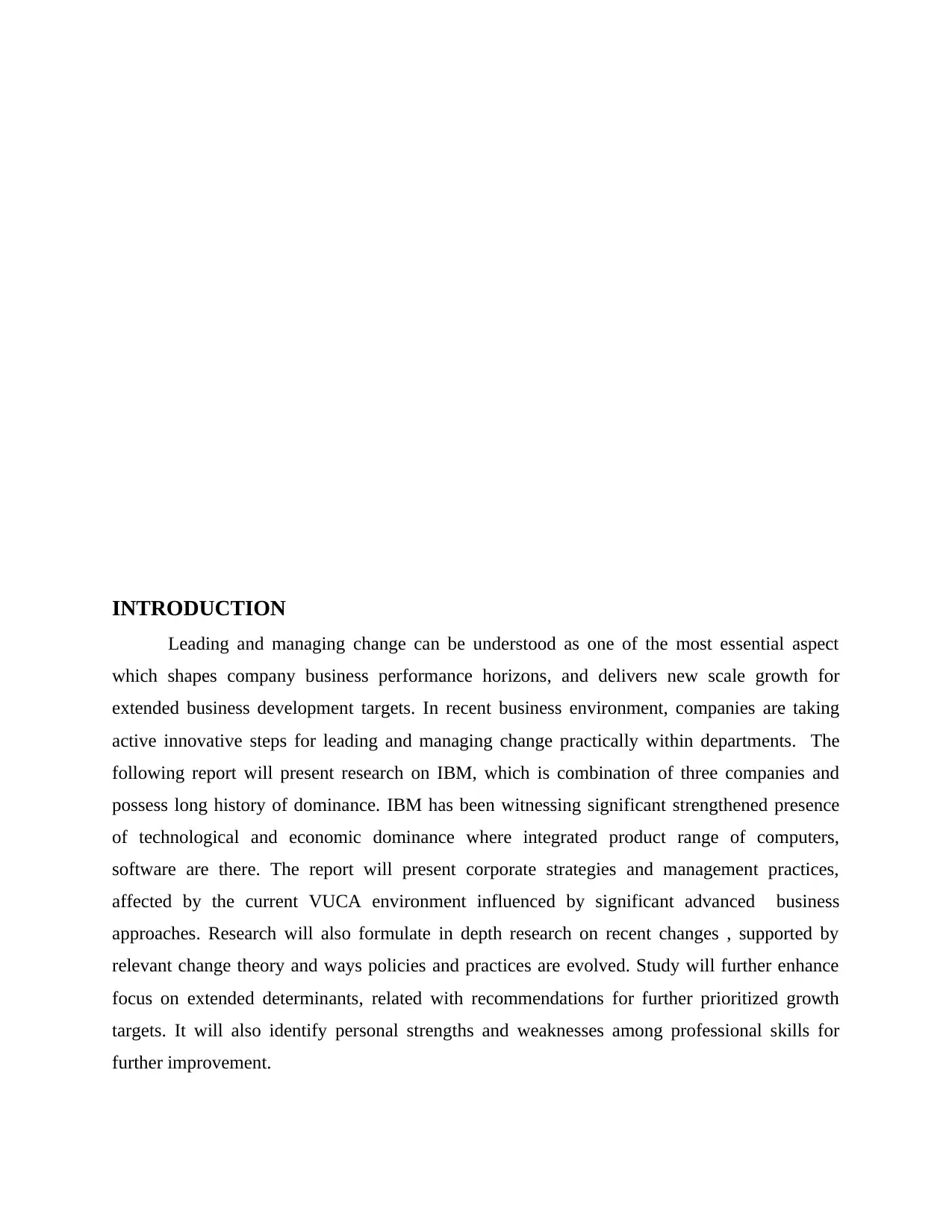
INTRODUCTION
Leading and managing change can be understood as one of the most essential aspect
which shapes company business performance horizons, and delivers new scale growth for
extended business development targets. In recent business environment, companies are taking
active innovative steps for leading and managing change practically within departments. The
following report will present research on IBM, which is combination of three companies and
possess long history of dominance. IBM has been witnessing significant strengthened presence
of technological and economic dominance where integrated product range of computers,
software are there. The report will present corporate strategies and management practices,
affected by the current VUCA environment influenced by significant advanced business
approaches. Research will also formulate in depth research on recent changes , supported by
relevant change theory and ways policies and practices are evolved. Study will further enhance
focus on extended determinants, related with recommendations for further prioritized growth
targets. It will also identify personal strengths and weaknesses among professional skills for
further improvement.
Leading and managing change can be understood as one of the most essential aspect
which shapes company business performance horizons, and delivers new scale growth for
extended business development targets. In recent business environment, companies are taking
active innovative steps for leading and managing change practically within departments. The
following report will present research on IBM, which is combination of three companies and
possess long history of dominance. IBM has been witnessing significant strengthened presence
of technological and economic dominance where integrated product range of computers,
software are there. The report will present corporate strategies and management practices,
affected by the current VUCA environment influenced by significant advanced business
approaches. Research will also formulate in depth research on recent changes , supported by
relevant change theory and ways policies and practices are evolved. Study will further enhance
focus on extended determinants, related with recommendations for further prioritized growth
targets. It will also identify personal strengths and weaknesses among professional skills for
further improvement.
Paraphrase This Document
Need a fresh take? Get an instant paraphrase of this document with our AI Paraphraser
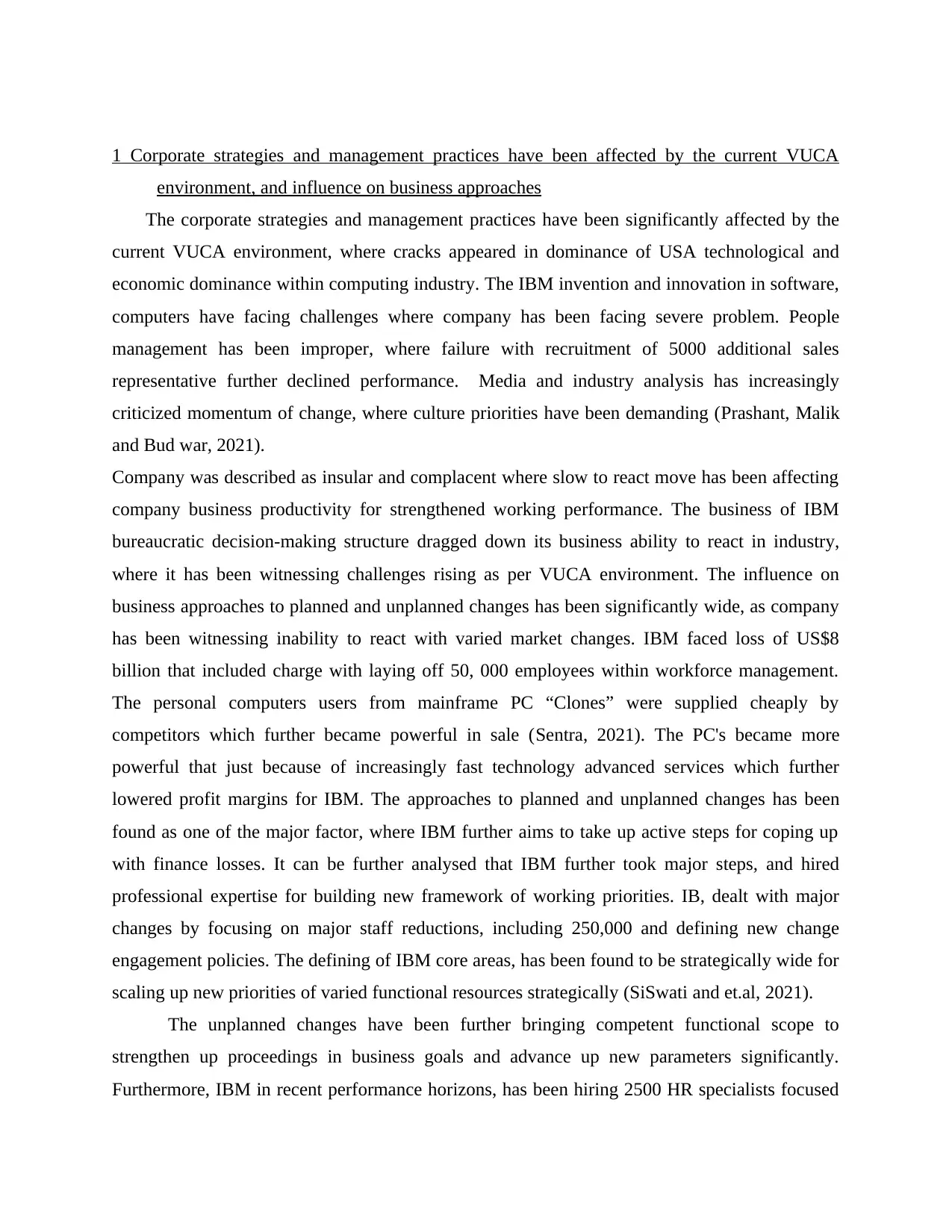
1 Corporate strategies and management practices have been affected by the current VUCA
environment, and influence on business approaches
The corporate strategies and management practices have been significantly affected by the
current VUCA environment, where cracks appeared in dominance of USA technological and
economic dominance within computing industry. The IBM invention and innovation in software,
computers have facing challenges where company has been facing severe problem. People
management has been improper, where failure with recruitment of 5000 additional sales
representative further declined performance. Media and industry analysis has increasingly
criticized momentum of change, where culture priorities have been demanding (Prashant, Malik
and Bud war, 2021).
Company was described as insular and complacent where slow to react move has been affecting
company business productivity for strengthened working performance. The business of IBM
bureaucratic decision-making structure dragged down its business ability to react in industry,
where it has been witnessing challenges rising as per VUCA environment. The influence on
business approaches to planned and unplanned changes has been significantly wide, as company
has been witnessing inability to react with varied market changes. IBM faced loss of US$8
billion that included charge with laying off 50, 000 employees within workforce management.
The personal computers users from mainframe PC “Clones” were supplied cheaply by
competitors which further became powerful in sale (Sentra, 2021). The PC's became more
powerful that just because of increasingly fast technology advanced services which further
lowered profit margins for IBM. The approaches to planned and unplanned changes has been
found as one of the major factor, where IBM further aims to take up active steps for coping up
with finance losses. It can be further analysed that IBM further took major steps, and hired
professional expertise for building new framework of working priorities. IB, dealt with major
changes by focusing on major staff reductions, including 250,000 and defining new change
engagement policies. The defining of IBM core areas, has been found to be strategically wide for
scaling up new priorities of varied functional resources strategically (SiSwati and et.al, 2021).
The unplanned changes have been further bringing competent functional scope to
strengthen up proceedings in business goals and advance up new parameters significantly.
Furthermore, IBM in recent performance horizons, has been hiring 2500 HR specialists focused
environment, and influence on business approaches
The corporate strategies and management practices have been significantly affected by the
current VUCA environment, where cracks appeared in dominance of USA technological and
economic dominance within computing industry. The IBM invention and innovation in software,
computers have facing challenges where company has been facing severe problem. People
management has been improper, where failure with recruitment of 5000 additional sales
representative further declined performance. Media and industry analysis has increasingly
criticized momentum of change, where culture priorities have been demanding (Prashant, Malik
and Bud war, 2021).
Company was described as insular and complacent where slow to react move has been affecting
company business productivity for strengthened working performance. The business of IBM
bureaucratic decision-making structure dragged down its business ability to react in industry,
where it has been witnessing challenges rising as per VUCA environment. The influence on
business approaches to planned and unplanned changes has been significantly wide, as company
has been witnessing inability to react with varied market changes. IBM faced loss of US$8
billion that included charge with laying off 50, 000 employees within workforce management.
The personal computers users from mainframe PC “Clones” were supplied cheaply by
competitors which further became powerful in sale (Sentra, 2021). The PC's became more
powerful that just because of increasingly fast technology advanced services which further
lowered profit margins for IBM. The approaches to planned and unplanned changes has been
found as one of the major factor, where IBM further aims to take up active steps for coping up
with finance losses. It can be further analysed that IBM further took major steps, and hired
professional expertise for building new framework of working priorities. IB, dealt with major
changes by focusing on major staff reductions, including 250,000 and defining new change
engagement policies. The defining of IBM core areas, has been found to be strategically wide for
scaling up new priorities of varied functional resources strategically (SiSwati and et.al, 2021).
The unplanned changes have been further bringing competent functional scope to
strengthen up proceedings in business goals and advance up new parameters significantly.
Furthermore, IBM in recent performance horizons, has been hiring 2500 HR specialists focused
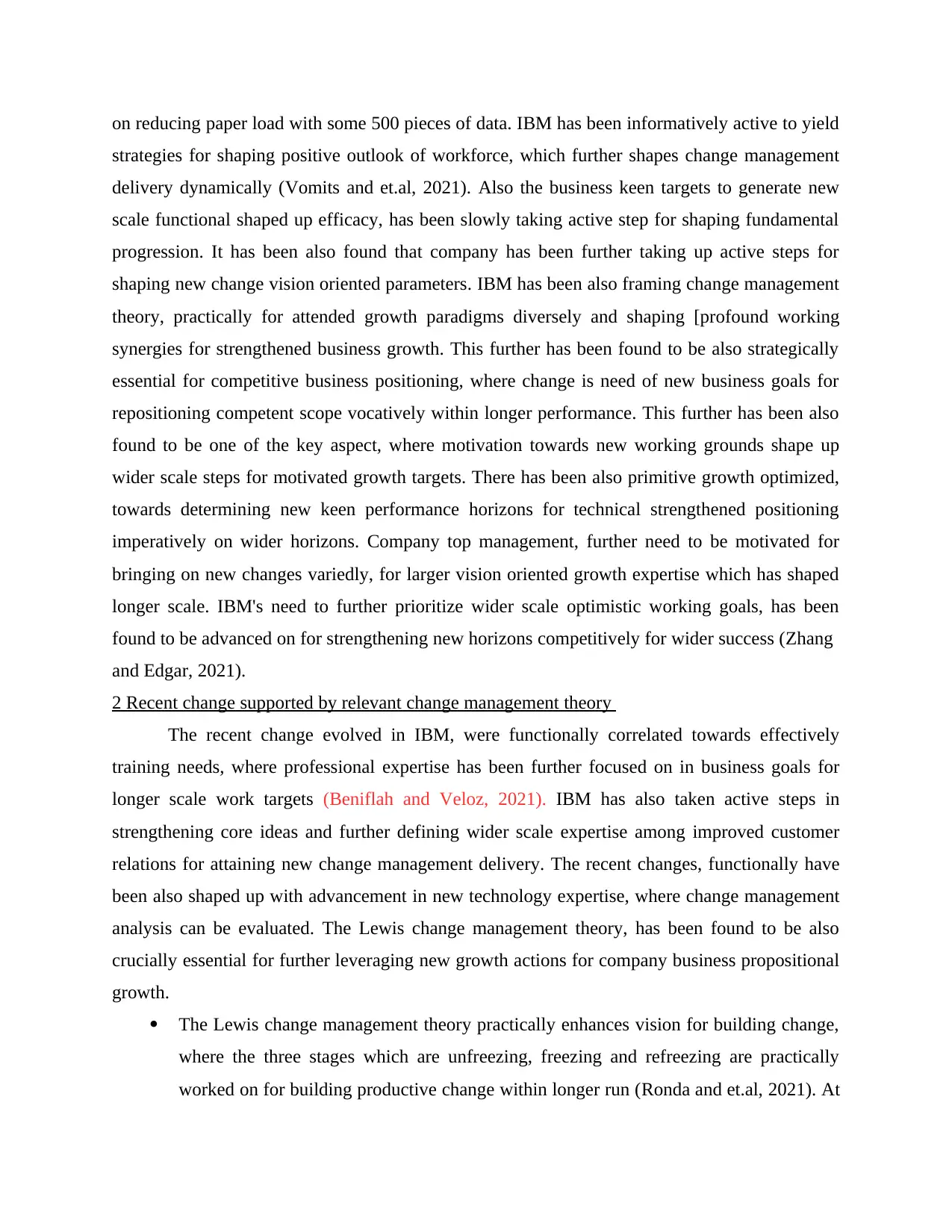
on reducing paper load with some 500 pieces of data. IBM has been informatively active to yield
strategies for shaping positive outlook of workforce, which further shapes change management
delivery dynamically (Vomits and et.al, 2021). Also the business keen targets to generate new
scale functional shaped up efficacy, has been slowly taking active step for shaping fundamental
progression. It has been also found that company has been further taking up active steps for
shaping new change vision oriented parameters. IBM has been also framing change management
theory, practically for attended growth paradigms diversely and shaping [profound working
synergies for strengthened business growth. This further has been found to be also strategically
essential for competitive business positioning, where change is need of new business goals for
repositioning competent scope vocatively within longer performance. This further has been also
found to be one of the key aspect, where motivation towards new working grounds shape up
wider scale steps for motivated growth targets. There has been also primitive growth optimized,
towards determining new keen performance horizons for technical strengthened positioning
imperatively on wider horizons. Company top management, further need to be motivated for
bringing on new changes variedly, for larger vision oriented growth expertise which has shaped
longer scale. IBM's need to further prioritize wider scale optimistic working goals, has been
found to be advanced on for strengthening new horizons competitively for wider success (Zhang
and Edgar, 2021).
2 Recent change supported by relevant change management theory
The recent change evolved in IBM, were functionally correlated towards effectively
training needs, where professional expertise has been further focused on in business goals for
longer scale work targets (Beniflah and Veloz, 2021). IBM has also taken active steps in
strengthening core ideas and further defining wider scale expertise among improved customer
relations for attaining new change management delivery. The recent changes, functionally have
been also shaped up with advancement in new technology expertise, where change management
analysis can be evaluated. The Lewis change management theory, has been found to be also
crucially essential for further leveraging new growth actions for company business propositional
growth.
The Lewis change management theory practically enhances vision for building change,
where the three stages which are unfreezing, freezing and refreezing are practically
worked on for building productive change within longer run (Ronda and et.al, 2021). At
strategies for shaping positive outlook of workforce, which further shapes change management
delivery dynamically (Vomits and et.al, 2021). Also the business keen targets to generate new
scale functional shaped up efficacy, has been slowly taking active step for shaping fundamental
progression. It has been also found that company has been further taking up active steps for
shaping new change vision oriented parameters. IBM has been also framing change management
theory, practically for attended growth paradigms diversely and shaping [profound working
synergies for strengthened business growth. This further has been found to be also strategically
essential for competitive business positioning, where change is need of new business goals for
repositioning competent scope vocatively within longer performance. This further has been also
found to be one of the key aspect, where motivation towards new working grounds shape up
wider scale steps for motivated growth targets. There has been also primitive growth optimized,
towards determining new keen performance horizons for technical strengthened positioning
imperatively on wider horizons. Company top management, further need to be motivated for
bringing on new changes variedly, for larger vision oriented growth expertise which has shaped
longer scale. IBM's need to further prioritize wider scale optimistic working goals, has been
found to be advanced on for strengthening new horizons competitively for wider success (Zhang
and Edgar, 2021).
2 Recent change supported by relevant change management theory
The recent change evolved in IBM, were functionally correlated towards effectively
training needs, where professional expertise has been further focused on in business goals for
longer scale work targets (Beniflah and Veloz, 2021). IBM has also taken active steps in
strengthening core ideas and further defining wider scale expertise among improved customer
relations for attaining new change management delivery. The recent changes, functionally have
been also shaped up with advancement in new technology expertise, where change management
analysis can be evaluated. The Lewis change management theory, has been found to be also
crucially essential for further leveraging new growth actions for company business propositional
growth.
The Lewis change management theory practically enhances vision for building change,
where the three stages which are unfreezing, freezing and refreezing are practically
worked on for building productive change within longer run (Ronda and et.al, 2021). At
⊘ This is a preview!⊘
Do you want full access?
Subscribe today to unlock all pages.

Trusted by 1+ million students worldwide
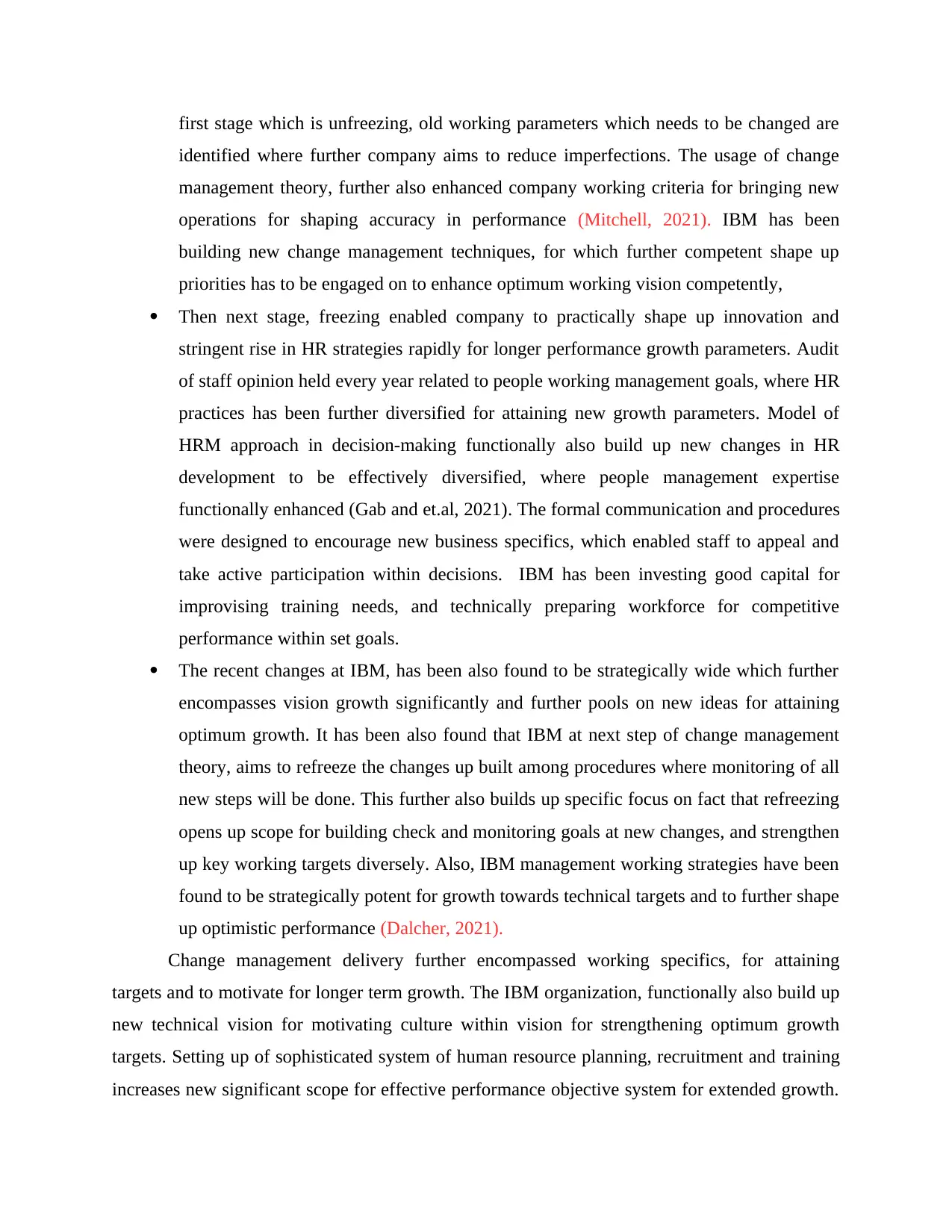
first stage which is unfreezing, old working parameters which needs to be changed are
identified where further company aims to reduce imperfections. The usage of change
management theory, further also enhanced company working criteria for bringing new
operations for shaping accuracy in performance (Mitchell, 2021). IBM has been
building new change management techniques, for which further competent shape up
priorities has to be engaged on to enhance optimum working vision competently,
Then next stage, freezing enabled company to practically shape up innovation and
stringent rise in HR strategies rapidly for longer performance growth parameters. Audit
of staff opinion held every year related to people working management goals, where HR
practices has been further diversified for attaining new growth parameters. Model of
HRM approach in decision-making functionally also build up new changes in HR
development to be effectively diversified, where people management expertise
functionally enhanced (Gab and et.al, 2021). The formal communication and procedures
were designed to encourage new business specifics, which enabled staff to appeal and
take active participation within decisions. IBM has been investing good capital for
improvising training needs, and technically preparing workforce for competitive
performance within set goals.
The recent changes at IBM, has been also found to be strategically wide which further
encompasses vision growth significantly and further pools on new ideas for attaining
optimum growth. It has been also found that IBM at next step of change management
theory, aims to refreeze the changes up built among procedures where monitoring of all
new steps will be done. This further also builds up specific focus on fact that refreezing
opens up scope for building check and monitoring goals at new changes, and strengthen
up key working targets diversely. Also, IBM management working strategies have been
found to be strategically potent for growth towards technical targets and to further shape
up optimistic performance (Dalcher, 2021).
Change management delivery further encompassed working specifics, for attaining
targets and to motivate for longer term growth. The IBM organization, functionally also build up
new technical vision for motivating culture within vision for strengthening optimum growth
targets. Setting up of sophisticated system of human resource planning, recruitment and training
increases new significant scope for effective performance objective system for extended growth.
identified where further company aims to reduce imperfections. The usage of change
management theory, further also enhanced company working criteria for bringing new
operations for shaping accuracy in performance (Mitchell, 2021). IBM has been
building new change management techniques, for which further competent shape up
priorities has to be engaged on to enhance optimum working vision competently,
Then next stage, freezing enabled company to practically shape up innovation and
stringent rise in HR strategies rapidly for longer performance growth parameters. Audit
of staff opinion held every year related to people working management goals, where HR
practices has been further diversified for attaining new growth parameters. Model of
HRM approach in decision-making functionally also build up new changes in HR
development to be effectively diversified, where people management expertise
functionally enhanced (Gab and et.al, 2021). The formal communication and procedures
were designed to encourage new business specifics, which enabled staff to appeal and
take active participation within decisions. IBM has been investing good capital for
improvising training needs, and technically preparing workforce for competitive
performance within set goals.
The recent changes at IBM, has been also found to be strategically wide which further
encompasses vision growth significantly and further pools on new ideas for attaining
optimum growth. It has been also found that IBM at next step of change management
theory, aims to refreeze the changes up built among procedures where monitoring of all
new steps will be done. This further also builds up specific focus on fact that refreezing
opens up scope for building check and monitoring goals at new changes, and strengthen
up key working targets diversely. Also, IBM management working strategies have been
found to be strategically potent for growth towards technical targets and to further shape
up optimistic performance (Dalcher, 2021).
Change management delivery further encompassed working specifics, for attaining
targets and to motivate for longer term growth. The IBM organization, functionally also build up
new technical vision for motivating culture within vision for strengthening optimum growth
targets. Setting up of sophisticated system of human resource planning, recruitment and training
increases new significant scope for effective performance objective system for extended growth.
Paraphrase This Document
Need a fresh take? Get an instant paraphrase of this document with our AI Paraphraser
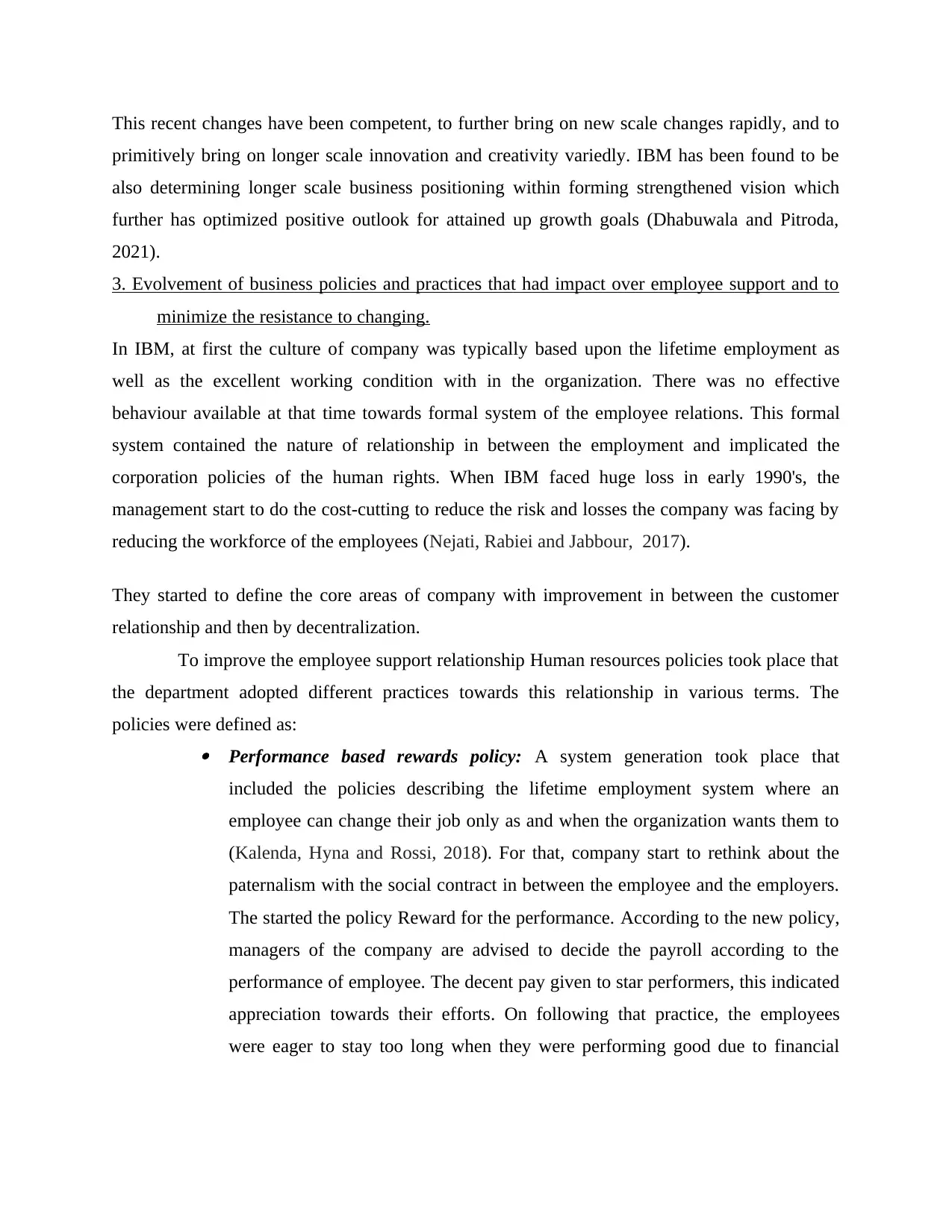
This recent changes have been competent, to further bring on new scale changes rapidly, and to
primitively bring on longer scale innovation and creativity variedly. IBM has been found to be
also determining longer scale business positioning within forming strengthened vision which
further has optimized positive outlook for attained up growth goals (Dhabuwala and Pitroda,
2021).
3. Evolvement of business policies and practices that had impact over employee support and to
minimize the resistance to changing.
In IBM, at first the culture of company was typically based upon the lifetime employment as
well as the excellent working condition with in the organization. There was no effective
behaviour available at that time towards formal system of the employee relations. This formal
system contained the nature of relationship in between the employment and implicated the
corporation policies of the human rights. When IBM faced huge loss in early 1990's, the
management start to do the cost-cutting to reduce the risk and losses the company was facing by
reducing the workforce of the employees (Nejati, Rabiei and Jabbour, 2017).
They started to define the core areas of company with improvement in between the customer
relationship and then by decentralization.
To improve the employee support relationship Human resources policies took place that
the department adopted different practices towards this relationship in various terms. The
policies were defined as:
Performance based rewards policy: A system generation took place that
included the policies describing the lifetime employment system where an
employee can change their job only as and when the organization wants them to
(Kalenda, Hyna and Rossi, 2018). For that, company start to rethink about the
paternalism with the social contract in between the employee and the employers.
The started the policy Reward for the performance. According to the new policy,
managers of the company are advised to decide the payroll according to the
performance of employee. The decent pay given to star performers, this indicated
appreciation towards their efforts. On following that practice, the employees
were eager to stay too long when they were performing good due to financial
primitively bring on longer scale innovation and creativity variedly. IBM has been found to be
also determining longer scale business positioning within forming strengthened vision which
further has optimized positive outlook for attained up growth goals (Dhabuwala and Pitroda,
2021).
3. Evolvement of business policies and practices that had impact over employee support and to
minimize the resistance to changing.
In IBM, at first the culture of company was typically based upon the lifetime employment as
well as the excellent working condition with in the organization. There was no effective
behaviour available at that time towards formal system of the employee relations. This formal
system contained the nature of relationship in between the employment and implicated the
corporation policies of the human rights. When IBM faced huge loss in early 1990's, the
management start to do the cost-cutting to reduce the risk and losses the company was facing by
reducing the workforce of the employees (Nejati, Rabiei and Jabbour, 2017).
They started to define the core areas of company with improvement in between the customer
relationship and then by decentralization.
To improve the employee support relationship Human resources policies took place that
the department adopted different practices towards this relationship in various terms. The
policies were defined as:
Performance based rewards policy: A system generation took place that
included the policies describing the lifetime employment system where an
employee can change their job only as and when the organization wants them to
(Kalenda, Hyna and Rossi, 2018). For that, company start to rethink about the
paternalism with the social contract in between the employee and the employers.
The started the policy Reward for the performance. According to the new policy,
managers of the company are advised to decide the payroll according to the
performance of employee. The decent pay given to star performers, this indicated
appreciation towards their efforts. On following that practice, the employees
were eager to stay too long when they were performing good due to financial
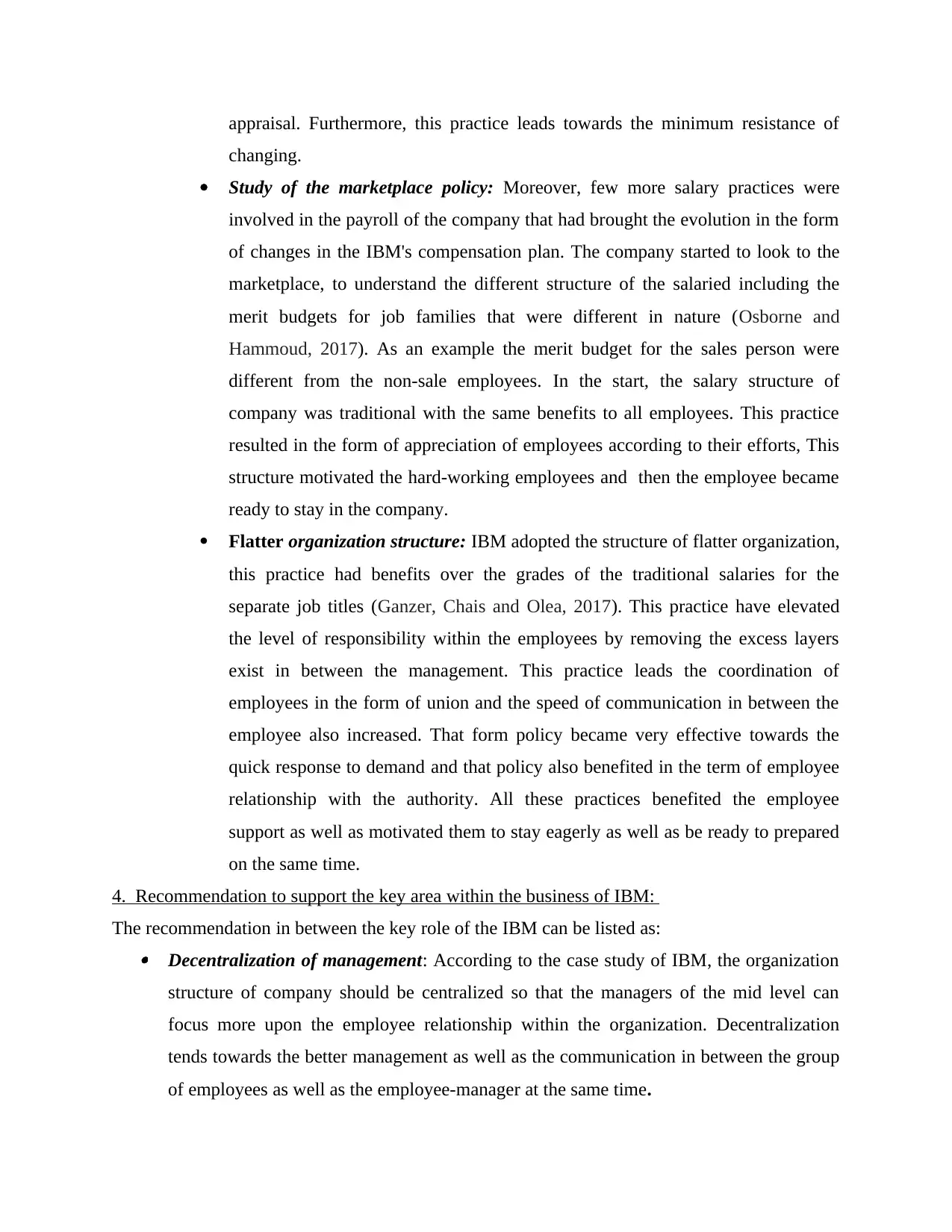
appraisal. Furthermore, this practice leads towards the minimum resistance of
changing.
Study of the marketplace policy: Moreover, few more salary practices were
involved in the payroll of the company that had brought the evolution in the form
of changes in the IBM's compensation plan. The company started to look to the
marketplace, to understand the different structure of the salaried including the
merit budgets for job families that were different in nature (Osborne and
Hammoud, 2017). As an example the merit budget for the sales person were
different from the non-sale employees. In the start, the salary structure of
company was traditional with the same benefits to all employees. This practice
resulted in the form of appreciation of employees according to their efforts, This
structure motivated the hard-working employees and then the employee became
ready to stay in the company.
Flatter organization structure: IBM adopted the structure of flatter organization,
this practice had benefits over the grades of the traditional salaries for the
separate job titles (Ganzer, Chais and Olea, 2017). This practice have elevated
the level of responsibility within the employees by removing the excess layers
exist in between the management. This practice leads the coordination of
employees in the form of union and the speed of communication in between the
employee also increased. That form policy became very effective towards the
quick response to demand and that policy also benefited in the term of employee
relationship with the authority. All these practices benefited the employee
support as well as motivated them to stay eagerly as well as be ready to prepared
on the same time.
4. Recommendation to support the key area within the business of IBM:
The recommendation in between the key role of the IBM can be listed as: Decentralization of management: According to the case study of IBM, the organization
structure of company should be centralized so that the managers of the mid level can
focus more upon the employee relationship within the organization. Decentralization
tends towards the better management as well as the communication in between the group
of employees as well as the employee-manager at the same time.
changing.
Study of the marketplace policy: Moreover, few more salary practices were
involved in the payroll of the company that had brought the evolution in the form
of changes in the IBM's compensation plan. The company started to look to the
marketplace, to understand the different structure of the salaried including the
merit budgets for job families that were different in nature (Osborne and
Hammoud, 2017). As an example the merit budget for the sales person were
different from the non-sale employees. In the start, the salary structure of
company was traditional with the same benefits to all employees. This practice
resulted in the form of appreciation of employees according to their efforts, This
structure motivated the hard-working employees and then the employee became
ready to stay in the company.
Flatter organization structure: IBM adopted the structure of flatter organization,
this practice had benefits over the grades of the traditional salaries for the
separate job titles (Ganzer, Chais and Olea, 2017). This practice have elevated
the level of responsibility within the employees by removing the excess layers
exist in between the management. This practice leads the coordination of
employees in the form of union and the speed of communication in between the
employee also increased. That form policy became very effective towards the
quick response to demand and that policy also benefited in the term of employee
relationship with the authority. All these practices benefited the employee
support as well as motivated them to stay eagerly as well as be ready to prepared
on the same time.
4. Recommendation to support the key area within the business of IBM:
The recommendation in between the key role of the IBM can be listed as: Decentralization of management: According to the case study of IBM, the organization
structure of company should be centralized so that the managers of the mid level can
focus more upon the employee relationship within the organization. Decentralization
tends towards the better management as well as the communication in between the group
of employees as well as the employee-manager at the same time.
⊘ This is a preview!⊘
Do you want full access?
Subscribe today to unlock all pages.

Trusted by 1+ million students worldwide
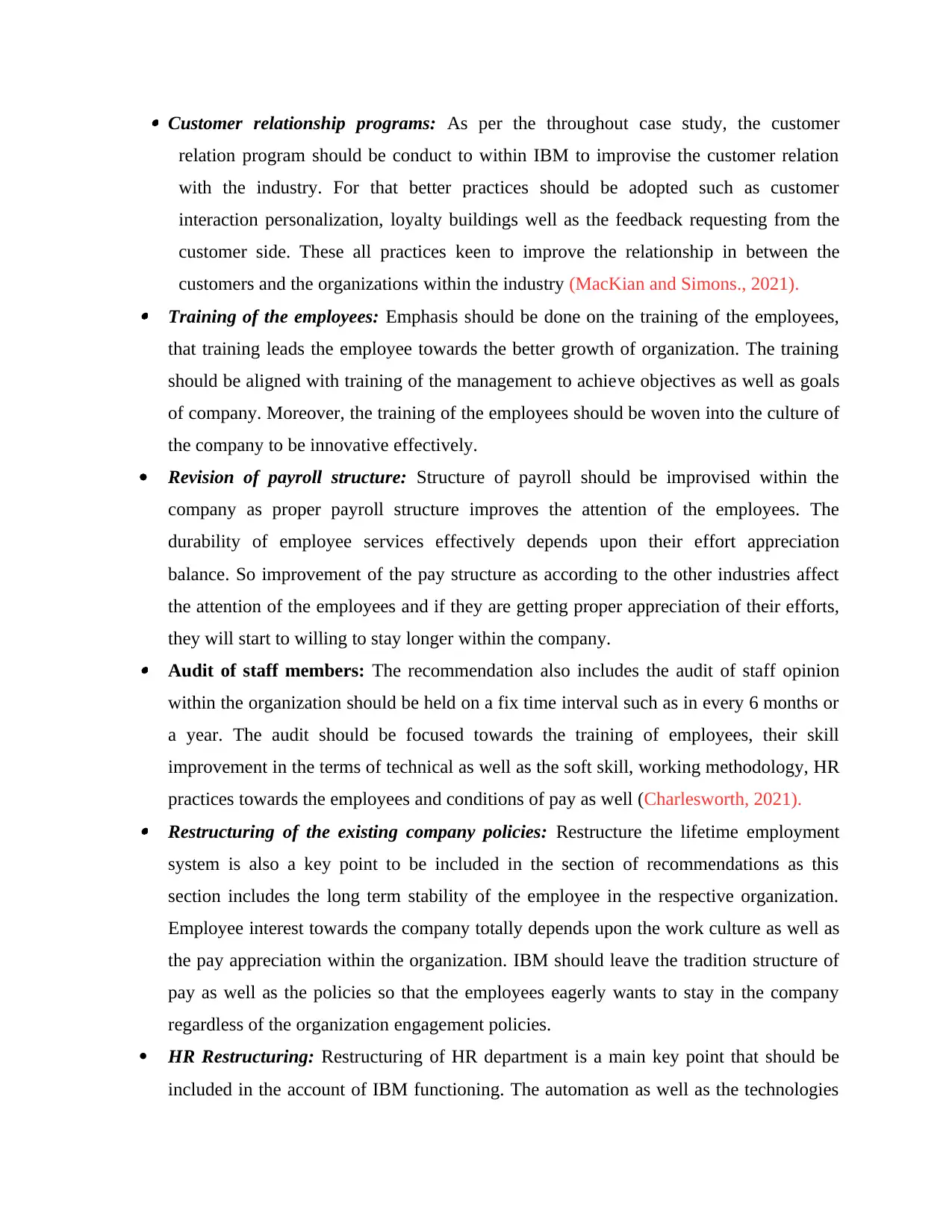
Customer relationship programs: As per the throughout case study, the customer
relation program should be conduct to within IBM to improvise the customer relation
with the industry. For that better practices should be adopted such as customer
interaction personalization, loyalty buildings well as the feedback requesting from the
customer side. These all practices keen to improve the relationship in between the
customers and the organizations within the industry (MacKian and Simons., 2021). Training of the employees: Emphasis should be done on the training of the employees,
that training leads the employee towards the better growth of organization. The training
should be aligned with training of the management to achieve objectives as well as goals
of company. Moreover, the training of the employees should be woven into the culture of
the company to be innovative effectively.
Revision of payroll structure: Structure of payroll should be improvised within the
company as proper payroll structure improves the attention of the employees. The
durability of employee services effectively depends upon their effort appreciation
balance. So improvement of the pay structure as according to the other industries affect
the attention of the employees and if they are getting proper appreciation of their efforts,
they will start to willing to stay longer within the company. Audit of staff members: The recommendation also includes the audit of staff opinion
within the organization should be held on a fix time interval such as in every 6 months or
a year. The audit should be focused towards the training of employees, their skill
improvement in the terms of technical as well as the soft skill, working methodology, HR
practices towards the employees and conditions of pay as well (Charlesworth, 2021). Restructuring of the existing company policies: Restructure the lifetime employment
system is also a key point to be included in the section of recommendations as this
section includes the long term stability of the employee in the respective organization.
Employee interest towards the company totally depends upon the work culture as well as
the pay appreciation within the organization. IBM should leave the tradition structure of
pay as well as the policies so that the employees eagerly wants to stay in the company
regardless of the organization engagement policies.
HR Restructuring: Restructuring of HR department is a main key point that should be
included in the account of IBM functioning. The automation as well as the technologies
relation program should be conduct to within IBM to improvise the customer relation
with the industry. For that better practices should be adopted such as customer
interaction personalization, loyalty buildings well as the feedback requesting from the
customer side. These all practices keen to improve the relationship in between the
customers and the organizations within the industry (MacKian and Simons., 2021). Training of the employees: Emphasis should be done on the training of the employees,
that training leads the employee towards the better growth of organization. The training
should be aligned with training of the management to achieve objectives as well as goals
of company. Moreover, the training of the employees should be woven into the culture of
the company to be innovative effectively.
Revision of payroll structure: Structure of payroll should be improvised within the
company as proper payroll structure improves the attention of the employees. The
durability of employee services effectively depends upon their effort appreciation
balance. So improvement of the pay structure as according to the other industries affect
the attention of the employees and if they are getting proper appreciation of their efforts,
they will start to willing to stay longer within the company. Audit of staff members: The recommendation also includes the audit of staff opinion
within the organization should be held on a fix time interval such as in every 6 months or
a year. The audit should be focused towards the training of employees, their skill
improvement in the terms of technical as well as the soft skill, working methodology, HR
practices towards the employees and conditions of pay as well (Charlesworth, 2021). Restructuring of the existing company policies: Restructure the lifetime employment
system is also a key point to be included in the section of recommendations as this
section includes the long term stability of the employee in the respective organization.
Employee interest towards the company totally depends upon the work culture as well as
the pay appreciation within the organization. IBM should leave the tradition structure of
pay as well as the policies so that the employees eagerly wants to stay in the company
regardless of the organization engagement policies.
HR Restructuring: Restructuring of HR department is a main key point that should be
included in the account of IBM functioning. The automation as well as the technologies
Paraphrase This Document
Need a fresh take? Get an instant paraphrase of this document with our AI Paraphraser
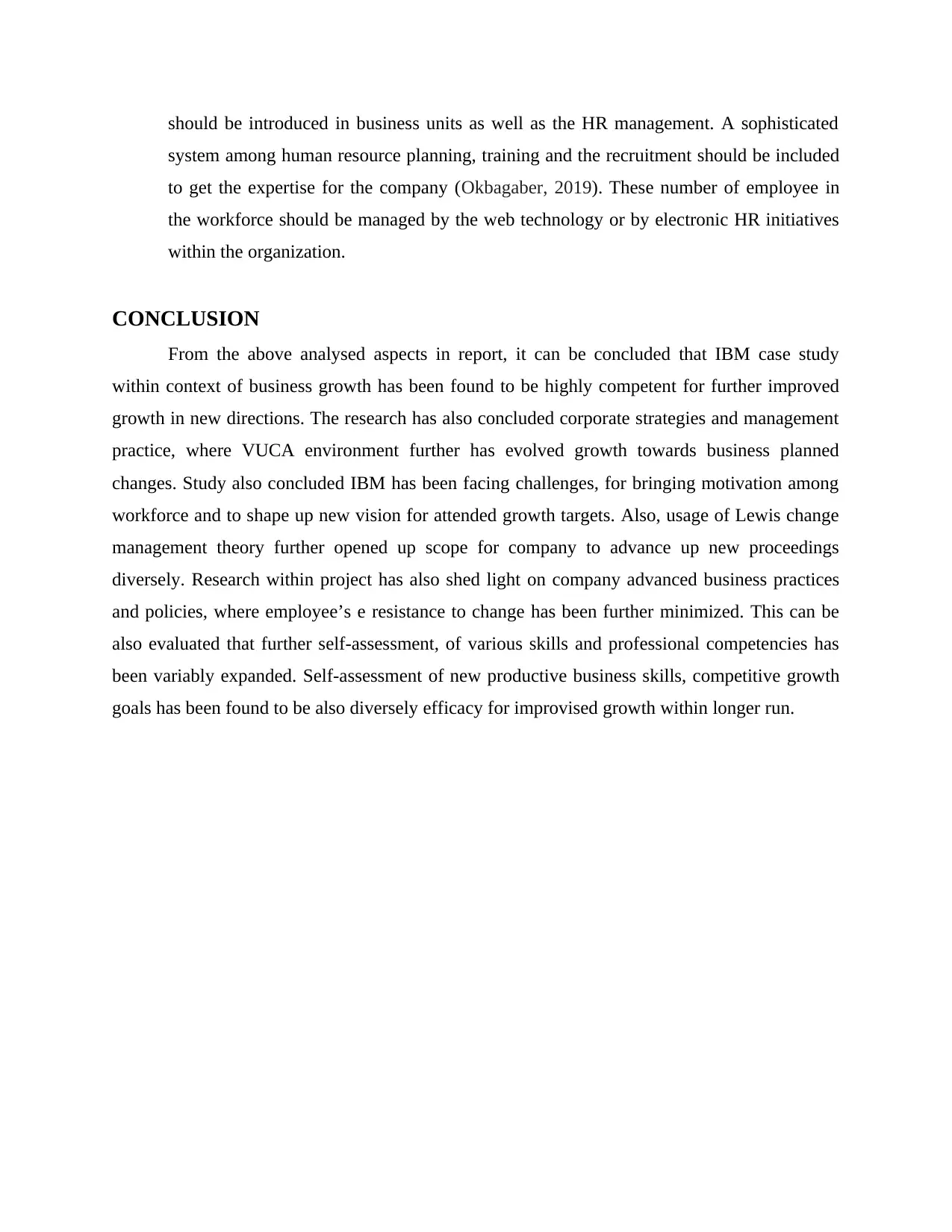
should be introduced in business units as well as the HR management. A sophisticated
system among human resource planning, training and the recruitment should be included
to get the expertise for the company (Okbagaber, 2019). These number of employee in
the workforce should be managed by the web technology or by electronic HR initiatives
within the organization.
CONCLUSION
From the above analysed aspects in report, it can be concluded that IBM case study
within context of business growth has been found to be highly competent for further improved
growth in new directions. The research has also concluded corporate strategies and management
practice, where VUCA environment further has evolved growth towards business planned
changes. Study also concluded IBM has been facing challenges, for bringing motivation among
workforce and to shape up new vision for attended growth targets. Also, usage of Lewis change
management theory further opened up scope for company to advance up new proceedings
diversely. Research within project has also shed light on company advanced business practices
and policies, where employee’s e resistance to change has been further minimized. This can be
also evaluated that further self-assessment, of various skills and professional competencies has
been variably expanded. Self-assessment of new productive business skills, competitive growth
goals has been found to be also diversely efficacy for improvised growth within longer run.
system among human resource planning, training and the recruitment should be included
to get the expertise for the company (Okbagaber, 2019). These number of employee in
the workforce should be managed by the web technology or by electronic HR initiatives
within the organization.
CONCLUSION
From the above analysed aspects in report, it can be concluded that IBM case study
within context of business growth has been found to be highly competent for further improved
growth in new directions. The research has also concluded corporate strategies and management
practice, where VUCA environment further has evolved growth towards business planned
changes. Study also concluded IBM has been facing challenges, for bringing motivation among
workforce and to shape up new vision for attended growth targets. Also, usage of Lewis change
management theory further opened up scope for company to advance up new proceedings
diversely. Research within project has also shed light on company advanced business practices
and policies, where employee’s e resistance to change has been further minimized. This can be
also evaluated that further self-assessment, of various skills and professional competencies has
been variably expanded. Self-assessment of new productive business skills, competitive growth
goals has been found to be also diversely efficacy for improvised growth within longer run.
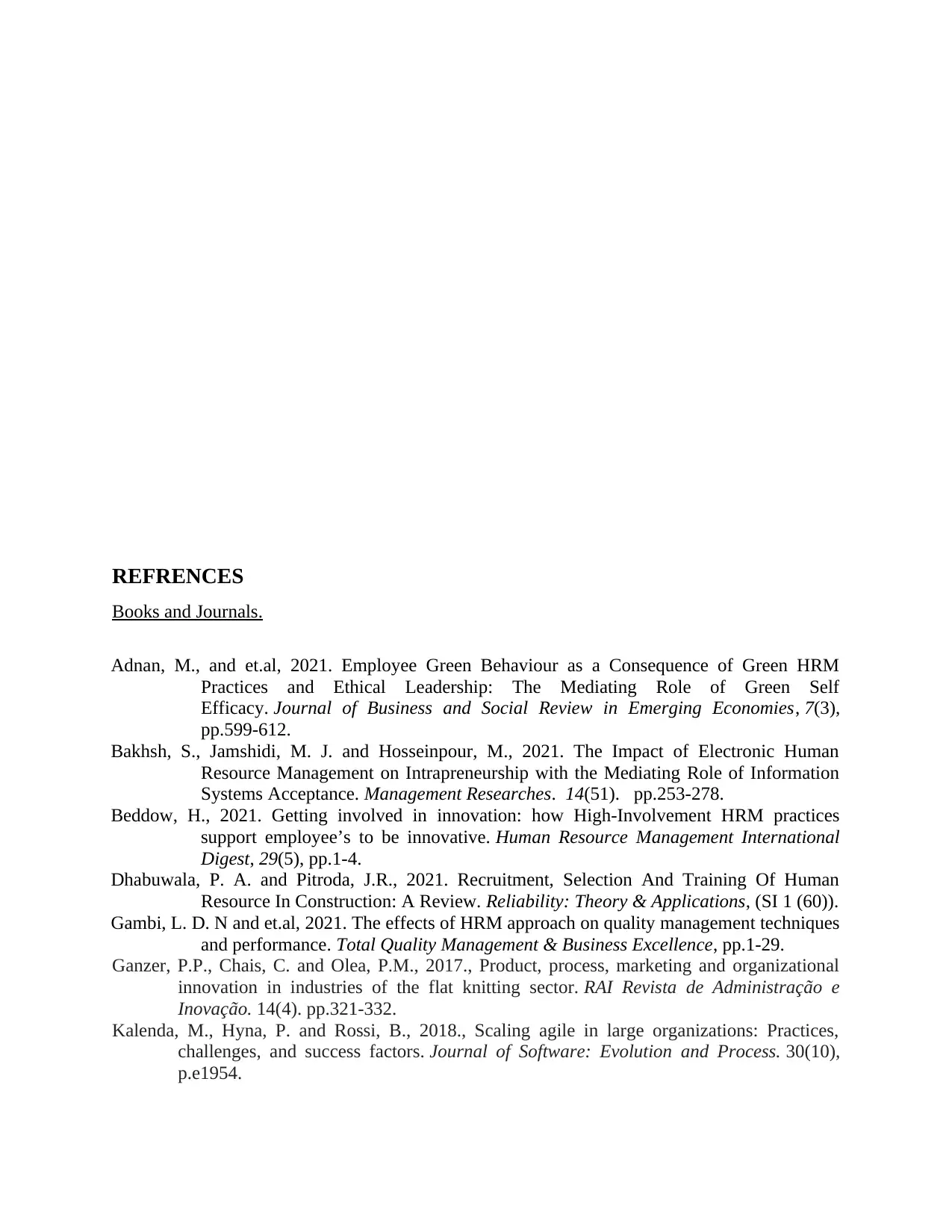
REFRENCES
Books and Journals.
Adnan, M., and et.al, 2021. Employee Green Behaviour as a Consequence of Green HRM
Practices and Ethical Leadership: The Mediating Role of Green Self
Efficacy. Journal of Business and Social Review in Emerging Economies, 7(3),
pp.599-612.
Bakhsh, S., Jamshidi, M. J. and Hosseinpour, M., 2021. The Impact of Electronic Human
Resource Management on Intrapreneurship with the Mediating Role of Information
Systems Acceptance. Management Researches. 14(51). pp.253-278.
Beddow, H., 2021. Getting involved in innovation: how High-Involvement HRM practices
support employee’s to be innovative. Human Resource Management International
Digest, 29(5), pp.1-4.
Dhabuwala, P. A. and Pitroda, J.R., 2021. Recruitment, Selection And Training Of Human
Resource In Construction: A Review. Reliability: Theory & Applications, (SI 1 (60)).
Gambi, L. D. N and et.al, 2021. The effects of HRM approach on quality management techniques
and performance. Total Quality Management & Business Excellence, pp.1-29.
Ganzer, P.P., Chais, C. and Olea, P.M., 2017., Product, process, marketing and organizational
innovation in industries of the flat knitting sector. RAI Revista de Administração e
Inovação. 14(4). pp.321-332.
Kalenda, M., Hyna, P. and Rossi, B., 2018., Scaling agile in large organizations: Practices,
challenges, and success factors. Journal of Software: Evolution and Process. 30(10),
p.e1954.
Books and Journals.
Adnan, M., and et.al, 2021. Employee Green Behaviour as a Consequence of Green HRM
Practices and Ethical Leadership: The Mediating Role of Green Self
Efficacy. Journal of Business and Social Review in Emerging Economies, 7(3),
pp.599-612.
Bakhsh, S., Jamshidi, M. J. and Hosseinpour, M., 2021. The Impact of Electronic Human
Resource Management on Intrapreneurship with the Mediating Role of Information
Systems Acceptance. Management Researches. 14(51). pp.253-278.
Beddow, H., 2021. Getting involved in innovation: how High-Involvement HRM practices
support employee’s to be innovative. Human Resource Management International
Digest, 29(5), pp.1-4.
Dhabuwala, P. A. and Pitroda, J.R., 2021. Recruitment, Selection And Training Of Human
Resource In Construction: A Review. Reliability: Theory & Applications, (SI 1 (60)).
Gambi, L. D. N and et.al, 2021. The effects of HRM approach on quality management techniques
and performance. Total Quality Management & Business Excellence, pp.1-29.
Ganzer, P.P., Chais, C. and Olea, P.M., 2017., Product, process, marketing and organizational
innovation in industries of the flat knitting sector. RAI Revista de Administração e
Inovação. 14(4). pp.321-332.
Kalenda, M., Hyna, P. and Rossi, B., 2018., Scaling agile in large organizations: Practices,
challenges, and success factors. Journal of Software: Evolution and Process. 30(10),
p.e1954.
⊘ This is a preview!⊘
Do you want full access?
Subscribe today to unlock all pages.

Trusted by 1+ million students worldwide
1 out of 15
Related Documents
Your All-in-One AI-Powered Toolkit for Academic Success.
+13062052269
info@desklib.com
Available 24*7 on WhatsApp / Email
![[object Object]](/_next/static/media/star-bottom.7253800d.svg)
Unlock your academic potential
Copyright © 2020–2025 A2Z Services. All Rights Reserved. Developed and managed by ZUCOL.




